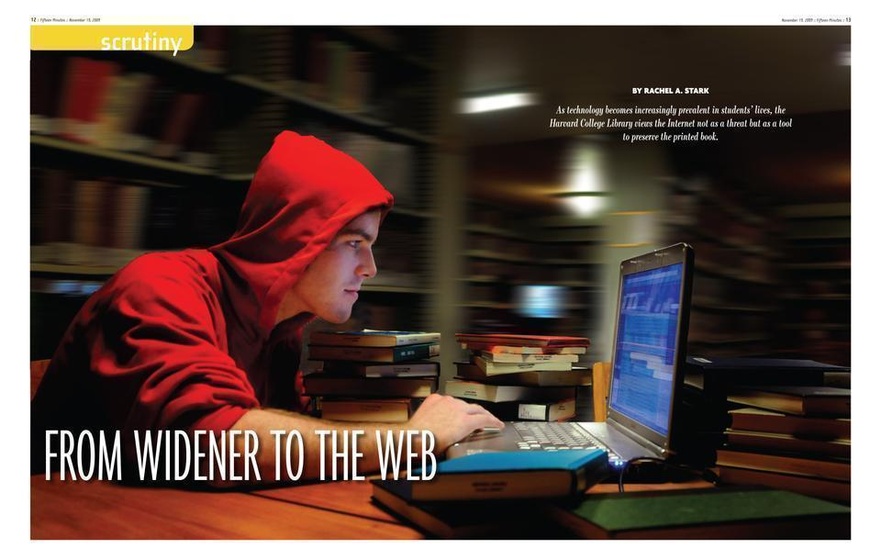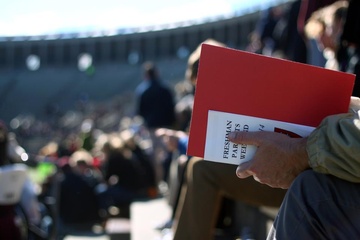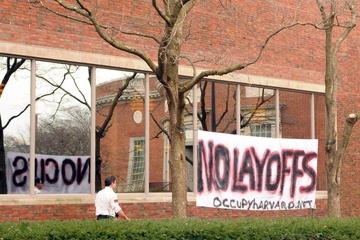Dan C. Hazen wandered around Peru, moving from Arequipa to Cuzco to Puno. He talked to locals, examined old newspapers and journals, and dug through a variety of governmental and private archives. It was 1972 and he was conducting research for his dissertation on 19th and early 20th century Indian rebellions in the southern highlands that border on Lake Titicaca and Bolivia.
“The process of assembling all of that data gave a different kind of nuance to the whole way that period of time was chronicled,” he says of the project.
Today Hazen sits in his office, papers strewn everywhere. A spider plant hangs from the ceiling. As the Associate Librarian for Collection Development at Harvard, Hazen oversees the acquisitions of one of the biggest library systems in the world. On the first floor of Widener, among the hundreds of stacks and hundreds of students on laptops, Hazen writes reports that emphasize a digital future. But he is not afraid to also wonder if something is lost in these new kinds of resources.
There is no question that this is where research is moving: the Harvard Task Force on University Libraries’ report, which came out last week, stated: “Perhaps most destabilizing to our operating model is the digital revolution. Though it is still in its early stages, it has already penetrated nearly all aspects of research and teaching.”
Yet it is also a time in which text resources are still highly valued and circulation numbers remain high. It is a time in which the boundaries between the world of text and digital resources remain unclear, where digital resources require personal interaction, where books are being energized digitally, and where the library itself is taking on physical transformations while finding its new place in the global scene.
OUT OF THE LIBRARY
Susan M. Gilroy enters the classroom in Emerson Hall. Petite and bright-eyed, the head of reference services at Lamont Library has already been briefed on the topics of the students’ tutorial papers. She wheels behind her a suitcase containing a projector, but—no need to use it—the room is already equipped with a computer connected to the Internet. The librarian proceeds to ask students more about their individual projects, pointing them to particular databases that might be useful as she weaves back and forth between the Harvard College Library (HCL) homepage and the world of e-resources.
As research moves into a digital age and resources become increasingly available online, the natural assumption might be that the library and librarians are losing their relevance. But as Professor of History Laurel T. Ulrich notes, this is certainly not the case. She is no stranger to the online world, having helped to digitize materials in Harvard’s museums as well as frequently using online databases like Visual Information Access system (VIA).
“We’re going to teach the students how to work with those digital materials because it’s not necessarily intuitive,” she says. “We find that even though students use iPods and iPhones and Blackberries and Facebook and YouTube and all of those things, they don’t always know how to do scholarly work online.”
For Karen L. Heath, a senior preceptor in Expository Writing, it is precisely because of the changing nature of resources that librarians have become increasingly more important.
“Because students are more likely to look for sources from their dorm room at two in the morning, they need that really good instruction about the stuff that isn’t helpful, that’s wrong, that wouldn’t be credible in an academic paper,” she says. “We need the librarians to help sort out how to tell what are the good ways of evaluating that stuff and how to find better stuff.”
Gilroy confirms that knowing where to find the best resources today is not intuitive; librarians are necessary not only to help sift through the mass of online research, but also to help evaluate the reliability of materials, both in terms of source and content. She stresses that HCL needs to make its own interface and database organization more user-friendly.
“I think that people assume that because someone can use technology they can use information well, and that’s not always the case,” Gilroy says.
So the digital world has become a world in need of personal interaction for HCL. It is common for librarians to enter classrooms, especially if they are a liaison for that particular department.
“We’re placing a high priority on classroom visits,” says the Roy E. Larsen Librarian of Harvard College Nancy M. Cline. “Undergrads are only here four years, they can’t waste one of the years not knowing how to do things well. We help people exploit what’s here and a lot of focus is on how to use online resources.”
Gilroy is quick to note that this librarian-student connection, though necessary in today’s age of digitalization, is nothing new.
“The library has always been a place where conversations are suppose to happen,” she says. “But we need to continually remind people that the library is not just a physical place, not just a warehouse, but that it’s a living system.”
Yet librarians are now engaging in a different kind of conversation.
“It becomes more important to be available outside of the building,” Gilroy says. HCL reaches out to students through all sorts of venues—classrooms, Houses, freshman dorms, and even online forms including blogs. She adds, “If we’re not tied to a physical collection, the access to the physical collection doesn’t have to begin with inside the building.”
Both Gilroy and Heath cannot foresee a time in which this intermediary assistance won’t be necessary.
As long as electronic information keeps growing, Heath says, there will be a need for experts who can help navigate that world.
“In person stuff is so critical,” Gilroy says. “There’s nothing like sitting down with people and talking about an idea whether it’s in the cafe over coffee or on the street corner.” She continues, “You don’t come to Harvard and know it all, you have to be shown. That’s the role of an intermediary, someone who’s trustworthy, authoritative, knowledgeable, who can at least point you in the right direction and know when to let go.”
While emphasizing the in-person part of this outreach, HCL also engages students through technologies like instant messaging for reference help. They also plan to test a text-a-librarian system, according to Susan M. Fliss, Associate Librarian of Harvard College for Research, Teaching and Learning. But Fliss notes that in-depth questions would still require personal contact.
ONTO THE WEB
As librarians march back and forth between their Widener offices and the classrooms in the Yard to teach about online resources, students have not stopped traveling the other way to use tangible sources. Circulation rates remain high, according to Gilroy.
“I think there’s this assumption that, particularly with special collections, that the more you put online the less reason people have to come and use the collections,” says Thomas A. Horrocks, Associate Librarian of Houghton Library for Collections. “That hasn’t proven to be true as we’re slowly but surely starting to digitize part of our collections.”
The office in the basement of Houghton Library is dimly lit, crowded with Abraham Lincoln busts, portraits, and books. One might wonder if they’ve stumbled into an overcrowded gift shop. Yet as this keeper of special collections pulls up Web page after Web page on Houghton’s Web site, he emphasizes that the images on the screen can actually help bring the people into the building.
“We have this increased mobility, we don’t have to be anchored within the midst of collection with all the pieces spread out,” Fliss says. “It’s exciting. We can show people selections of rare books, music scores and yet that serves as an invitation to bring people in to see the depth of existing collections.”
Horrocks says that this is the hope: that digitizing collections will actually have the effect of drawing people in to see physical holdings.
“People will discover these things not by thinking I’ll go to Houghton, but these things are all Google-able. People doing a John Updike search come across the Houghton blog entry and then come to Houghton library and hopefully start reading the other entries. Updike’s getting a lot of hits,” Horrocks says, pulling up the Web page for Houghton’s Longfellow Exhibition.
And Horrocks is not alone. Throughout HCL, librarians hope that the digital world will draw people back into the world of books. Hazen describes new online initiatives that will encourage this behavoir.
“We’re finding ways to energize analog resources in the catalog,” Hazen says. “Often in Hollis you get a flat record, it gives you what used to be considered adequate info about a book, but when you look at that as opposed to looking at a listing in Amazon with a cover, snippets, reviews, all this sort of stuff makes it a much more engaging interaction.”
Hazen says that the library system began using the provider Syndetic Solutions in the past year, which aims to “enhance library online catalogs” through various types of information and images.
Hazen believes that texts must continue to be energized within HCL, as current efforts have been inconsistent.
BACK TO THE STACKS
Students sit in Widener’s periodicals room, surrounded by magazines and newspapers. They click away on their netbooks, miniature laptop computers available for loan at the reference desk. An HLC news bulletin boasts that netbooks allow students to peruse electronic journals and “to continue to be able to read those titles in the comfort of the Periodicals Reading Room.”
The room, which contains dozens of magazines and newspapers, is now a site to read dozens of online magazines and newspapers, as subscriptions begin to be cancelled.
In addition to the “netbooks,” HCL has carved out a place within Lamont devoted to new types of learning, which include digital initiatives.
“I’m so excited,” Fliss says as she describes Lamont’s new collaborative learning space. The room includes two built-in projectors and screens, ten laptops, a DVD player, a VCR, document camera and wireless control system. Here, librarians can teach students about using resources. It is a different world from Horrocks’ office, full of Lincoln memorabilia.
While new measures focus on the classroom and the Internet, HCL has not ignored its own building, proposing new rooms and new materials to engage patrons as it moves into the digital world.
INTO THE WORLD
As librarians march into classrooms around campus and answer questions via Instant Messaging in cyber space, it seems as though HCL has mastered the realms of physical and digital resources.
“We all feel that we’re pretty empowered,” Cline says, from her large office overlooking Tercentenary Theater. “Librarians don’t teach the content, but the tools, the databases, which keep changing so fast that it’s hard for students to keep up with them.”
Yet this ever-expanding network of resources causes certain problems.
“The library can no longer make the same kind of claim to authority,” Hazen says. “Libraries used to say we have everything or virtually everything that someone wants to know about just because we can wrap our arms around the universe and scoop it in. Today there’s almost nothing that a library can make a claim about. We find ourselves in a niche of holding onto this claim of being comprehensive and a reality that everything is swirling, spilling and overwhelming our abilities of making sense.”
He continues, “It puts librarians and library collections in a strange place where we’re struggling to figure out what can we say about what we’re doing, what our collection means relative to the universe out there, what kinds of service and support the library can provide to people in making sense of what’s out there.”
John G. Palfrey, the Vice Dean for Library and Information Resources at the Harvard Law School, says he sees a fundamental shift within HCL, moving from possession of resources to access. “This is quite jarring for Harvard where historically we have sought to control objects in every field,” Palfrey says.
The recent Taskforce’s report acknowledged this fact. “Harvard libraries can no longer harbor delusions of being a completely comprehensive collection,” it stated. One of the report’s primary goals is to “collaborate more ambitiously with peer libraries and other institutions.”
Hazen explains one difficulty, though. Universities are naturally competitive, yet need to adjust to a world where there must be interdependency between their digital collections. For this librarian, the fact that one university will try to acquire poetry collections from Mexico, while another does so from Argentina means that, in providing access to their digital acquisitions, both communities benefit from their own strength.
This fluidity of resources among libraries will change how they are evaluated.
“We’re in a strange time where the traditional measures for judging libraries are under fire. As recently as 10 or 20 years ago the only number that really seemed to count was how many books, and Harvard could always afford to say that’s not really what should be counted,” Hazen says. “Now when we think of that libraries, they’re less free standing autonomous entities. We have to look at libraries as part of networks, webs of knowledge, collections that are all over the place.”
Cline says that Harvard has been working with members of the Association of Research Libraries to determine the new criteria for judging libraries, which she notes is hard to do as each has different costs and needs.
AND FOR THE STUDENTS
These changes, which balance text and digital resources, hope to improve the patron’s library experience.
However, many students don’t see the need for personal librarian assistance in navigating e-materials.
“I don’t feel like I’ve missed out on Harvard’s resources,” says Geoffrey A. Smith ’10 whose experience with librarians has not been useful. “It seems like in general the specific instruction needed for your discipline or class will be better provided from someone in that field, like a TF or a professor. A lot of classes have specialized tools for accessing resources or specific databases they expect you to use.”
For others, the libraries do not serve any other purpose than to take out the occasional book. Tim M. Jundanian ’10 jokes that he’s only been to a library when he lived next to one freshman year and when the Quad library was still open. He says that geographical proximity is important.
Yet for many the impact of HCL’s changes is clear.
Stephany Y. Lin ’11, who is researching both on Copenhagen’s wind turbines and Turkish immigrants in Northern Europe, is in the process of setting up an appointment with a librarian. Probably Gilroy, who came to her Junior Tutorial class earlier this semester.
“I think my problem has been that I’m not focused enough when I use online resources. I end up searching a bunch of places, but not using any one resource to its fullest capacity,” Lin says. “It’s hard to tell which ones are best suited for my particular need, particular project. I think we will always need the intermediate help of librarians, another eye to help navigate all the materials.”
Julia M. Taylor ’10, a Religion concentrator writing her thesis on the relationship between myth-making and “The Matrix,” sits in Currier Dining Hall reading one of Widener’s copies of “Lolita.” She reflects on librarians’ ability to help students as online resources expand. Pam Matz, a librarian who works with the Religion department spent half an hour working with Taylor. Matz figured out an exact combination of search terms for a specific database to trigger certain tags, something which Taylor says she would not have known how to do on her own.
“There are so many new technical developments that will continue to make librarians very important,” Taylor says. “They figure out how to use these new resources and digital stuff, have meetings about it, they learn about these databases endlessly.” She puts aside her library book. “Research librarians will always have a one-up on students because that’s what they do all day.”





